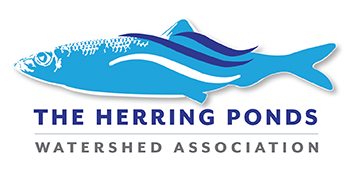General Information:
Health Risks High for Communities Surrounding Great Herring Pond:
We have a report that a dog that was swimming (and drinking the water) took ill but is recovering. The evidence is pretty clear that this cyanobacteria bloom is toxic. Go to The Herring Ponds Watershed Association website or Facebook page for daily posts on the ponds status. These can be found by googling “Herring Ponds Watershed Association.”
Here are the facts the Great Herring Pond Watershed Association identified and action points suggested to local area residents and recreational non residents:
- In order to re-open Great Herring Pond (GHP), two successive weeks of testing with no cyanobacteria present will be necessary.
- There is no way of knowing how long the bloom will last.
- The bloom is extensive and we still have most of the summer heat to contend with.
- It is the first cyanobacteria bloom on GHP for at least 80 years according to old timers who have never seen such a bloom. It is clear that once blooms start on a pond that they are more likely to reoccur in subsequent years.
Working together:
- Our community has to work together to minimize nutrient entrance into our ponds.
- The Herring Ponds Watershed Association will monitor the status of the bloom and, once it seems to have dissipated, take the necessary samples for testing so that the pond can re-open.
- The Herring Ponds Watershed Association is working with David Gould to fund an $80,000 study that will result in a Water Quality Plan that will both identify the likely sources of nutrients (in order of importance) and suggest ways to remediate this pollution.
- The Herring Ponds Watershed Association must raise $10,000 as our share of this study, so be generous when asked to help out.
- To clarify the cyanobacteria testing status, David Gould had a sample taken yesterday and results should be available “in a couple of days.” He agreed to take another sample next week; these first two samples will be paid for by Plymouth.
- Fish taken from GHP are NOT safe to eat. Dogs and humans have suffered from exposure. Birds eating contaminated fish are also at risk.
If you would like more information, click here.
Don Williams, President
Herring Ponds Watershed Association
Updates:
 September 24, 2020
September 24, 2020
Great Herring Pond Cyanobacteria Bloom – What Happened?
Notification
I got the notification early afternoon of Friday, July 17 from David Gould, head of Plymouth’s Department of Marine and Environmental Affairs. His email said that a resident had sent pictures of a Great Herring Pond bloom that had been confirmed to be a cyanobacteria bloom. He had posted warning signs at the boat ramp and at two homeowner association beaches.
What Did the Herring Ponds Watershed Association Do?
As president of HPWA, I realized that our most important duty was to protect the safety of our watershed families and pets and all other users of Great Herring Pond. Accordingly, we took the following steps:
- Encouraged Plymouth to take samples to test for the severity (concentration) of the cyanobacteria
- Borrowed the Plymouth microscope and fluorometer; my wife Geri took pictures and sent them to Hilary Snook, cyanobacteria expert of the regional EPA
- Patrolled the waters often starting early Saturday morning to warn fishermen, swimmers and pet owners that the cyanobacteria bloom posed significant health problems to children, dogs and even adults through contact or ingestion of the contaminated water
- Jerry Levine arranged for a printer to prepare a dozen large warning signs that he and I posted at the boat ramp and at all homeowner association beaches
- Continuously monitored the pond, taking Secchi Disk readings (clarity), noting color changes, recording fluorometer data that gave a rough indication of bloom severity and taking pictures of the bloom
- Posted regular updates and answered questions via Constant Contact, Facebook and our website (thanks to Beth Sobiloff and Geri)
- Shared data with David Gould and Hilary Snook to look for decreasing bloom severity
- In conjunction with Wildlands Trust, arranged for a well-attended Zoom Seminar by Hilary Snook on Cyanobacteria Blooms where he gave a comprehensive presentation and answered questions
- Held a Herring Ponds Watershed Association General Meeting where I provided bloom information and answered question
What Did Our Residents Do?
Once the word got out, the response from our residents was overwhelming:
- Most stayed out of the water and kept dogs away
- Excellent questions were asked and many learned a lot about cyanobacteria
- Observations regarding changes in the pond were sent to us
- Donations were received that put us over the top for raising HPWA’s share of the cost of the Water Quality Plan
What Caused the Cyanobacteria Bloom?
Those who had lived on the pond all their lives had never seen a cyanobacteria bloom on Great Herring Pond. Based on my knowledge and research (I had attended a lecture and a workshop by Hilary Snook previously), I put together the following list of causes. I believe that we were victims of a “Perfect Storm” of conditions that favored a cyanobacteria bloom.
- Warm winter so water temperatures started off higher than usual (high water temperatures favor cyanobacteria blooms over algae blooms)
- Water temperatures were high this summer, peaking at 84o F
- Low snowfall meant less snow melt during the spring to cleanse the pond
- Hot, sunny days favor chlorophyll-containing cyanobacteria viability
- Dry conditions reduced pond cleansing
- Two “gully-washer” rainstorms during the week of July 5 provided nutrients/pollutants to fuel cyanobacteria growth
Next Steps – Resident Actions and Water Quality Plan
The “Perfect Storm” argument does not guarantee that another bloom will never happen. Another bloom could happen. This causes great concern for HPWA; the loss of 2 months of summer access is much more than just an inconvenience. We must find the causes of these blooms and eliminate them.
If you review the cyanobacteria Causes list above, all but one are weather- or climate-related. The only cause that we can control is the nutrient/pollutant ingress into our pond.
Residents can do the following to help reduce pond pollution:
- Pump out septic tanks/cesspools every 3 – 5 years
- Clean up after pets
- Don’t fertilize close to the pond
- Don’t dump yard waste into the pond
- Prevent runoff by not clear-cutting
You have already contributed generously to allow us (if Plymouth’s share of $70,000 is approved at Fall Town Meeting on October 17) to raise HPWA’s $10,000 share of the cost of our watershed Water Quality Plan. This plan will provide two very important pieces of information:
- Relative amounts of nutrients/pollutants from each source
- Ways to reduce the pollution
The study that will form the basis of the plan should start this fall. It is most important to know what we can do to reduce pollution. It is important that we confirm that runoff is an influential component for generating cyanobacteria blooms. It is also important to identify where the main runoff areas are in our watershed.
Please feel free to email me at donald_r_williams2003@yahoo.com for more information. Thanks for your support of our vision.
Don Williams, President
Herring Ponds Watershed Association
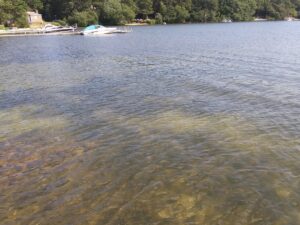 September 11, 2020
September 11, 2020
Great News! Great Herring Pond Re-Opened!
Two weeks ago today, the 2-week countdown clock started to re-open Great Herring Pond. The Plymouth Health Department gave us the word today that the pond is officially clear of cyanobacteria. Several other Plymouth Ponds are experiencing significant cyanobacteria blooms at this time. Our goal will be to do what is necessary to prevent these blooms in the future. With your help and with the results that will be obtained by the Water Quality Plan, we will learn more about how to prevent these disturbing interruptions of summer fun.
Stay tuned for a more thorough de-briefing of what we have learned from this experience. We have been doing well managing our water quality but we need to do better. Thanks to Plymouth for helping us to monitor the progress of the bloom, to Hilary Snook of the EPA for identifying the cyanobacteria and to my wife Geri whose microscopy and fluorometer work speeded up the timetable for reopening.
Finally, thanks to all of you for your patience and understanding.
Don Williams, President
Herring Ponds Watershed Association
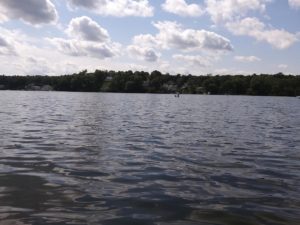 August 28, 2020
August 28, 2020
The Second Step on the Way to Re-Open Great Herring Pond!
David Gould’s Thursday follow-up ride with Geri and I on Great Herring Pond was cancelled due to the afternoon rains, but David came out with us this morning, decided the pond was clear enough and gave us the go-ahead for the “2-week countdown” starting today, Friday August 28!
Once the pond is declared “clear,” the pond can be opened two weeks later provided no additional blooms occur during that time period. We have now taken the second important step in the process to reopen Great Herring Pond. The reason for the 2 week delay is that even though the cyanobacteria is dead, the toxin can be still active for that time period.
If all goes well, Great Herring Pond will be open on Friday, September 11, just in time for the weekend. Geri and I will continue to patrol the pond, measuring Secchi Disk clarity and taking fluorometer readings to make sure that the improvement trend continues.
Meanwhile, be well and stay safe. You should still stay out of the water, don’t drink it and keep children and dogs away. Thanks so very much for your cooperation and support during this difficult time.
Don Williams, President
Herring Ponds Watershed Association
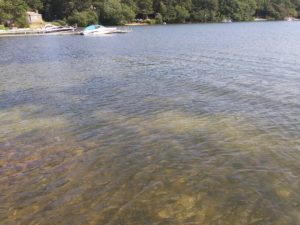 August 25, 2020
August 25, 2020
The First Step on the Way to Re-Open!
Many of you have noticed distinct improvements in the condition of Great Herring Pond. First the particulate matter got smaller and then it virtually disappeared. My wife Geri has been sampling the pond over this time period and has done microscopy and fluorometer readings that reinforce the idea of continuous improvement. Secchi disk readings, measuring clarity are slowly but steadily improving. The “slicks,” “sworls” and “mats” are long gone.
You will recall that once the pond is declared “clear,” the pond can be opened two weeks later provided no additional blooms occur during that time period. We have taken the first important step in the process to reopen Great Herring Pond. Today, Geri and I took David Gould, head of the Plymouth Department of Marine and Environmental Affairs, around the pond. David told us that he was surprised that Great Herring Pond “looked as good as it did.” He said he will come back on Thursday and check again with the possibility that Thursday will be the start of the “2-week countdown” to a safe re-opening.
Watch for Thursday’s post.
Meanwhile, be well and stay safe. You should still stay out of the water, don’t drink it and keep children and dogs away.
Don Williams, President
Herring Ponds Watershed Association
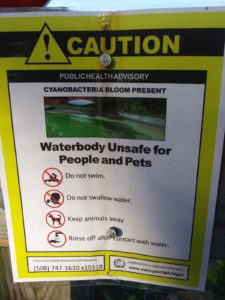 August 16, 2020
August 16, 2020
Testing Shows Toxic Cyanobacteria Present
Plymouth received the testing results at long last and forwarded them on to me. The lab detected small amounts of several different toxic cyanobacteria in the samples from both weeks.
I asked Kim Tower about what needs to happen before we can re-open. The State Department of Public Health procedure is that municipalities must issue an advisory when there is a visible cyanobacteria bloom. The advisory remains in effect until the water is clear for two weeks in a row. At that point, Plymouth Public Health Department will contact the State Department of Public Health for approval to lift the advisory.
The fact remains, however, that there is still a visible amount of microcystis present. The health advisory remains in effect and contact with the water in Great Herring Pond should be avoided, especially for dogs and children. Please be safe; we cannot predict who will have an allergic reaction upon contact with the tainted water.
We can hope that the cyanobacteria will be flushed out by the action of Little Herring Pond and Great Herring Pond springs and/or that the cyanobacteria will eventually run out of phosphorus nutrient/pollutant. We will continue to monitor the situation and report the status to you and to Plymouth.
If you would like more information on Cyanobacteria from an EPA expert, sign up for Hillary Snook’s program on, August 20th at 7pm. REGISTER HERE or at https://wildlandstrust.org/events/cyanobacteria-talk-2020.
We will keep you updated. Meanwhile, be safe. You can always visit the ocean. Scusset and Onset Beaches are beautiful places.
Don Williams, President
Herring Ponds Watershed Association
 August 11, 2020
August 11, 2020
Friends and Neighbors of Herring Ponds,
We are looking to replace the green water of the last few weeks with the clean blue water in the right hand picture.
It is certainly frustrating that we have not received lab results about the level of cyanobacteria in Great Herring Pond. I have been talking with Kim Tower (Plymouth Department of Marine and Environmental Affairs) about this situation and we have decided to forego the test as a metric to open up the pond. Instead, we will monitor the pond ourselves and, when the pond appears clear, enlist the expertise of the Plymouth Board of Health to verify. We will need two weeks in a row of being clear; we can do this by visual inspection.
My wife Geri’s microscopy pictures were sent to Hilary Snook, the regional EPA’s cyanobacteria expert, who confirmed the identity (microcystis) of the cyanobacteria and that it is toxic. She will continue to take samples and evaluate them.
There are still a lot of cyanobacteria throughout Great Herring Pond. We toured the pond on Sunday and took another sample for microscopic analysis. Geri found many cyanobacteria microcystis colonies. We must continue to stay out of the water and take special precautions with small children and dogs.
I have been asked why Ezekiel Pond has been cleared to open. The situation at Ezekiel Pond was quite different from ours. Their bloom appeared on Friday and disappeared on Monday. The two-week clock started on that Monday and two weeks later, with no recurrences of the bloom, Ezekiel Pond was re-opened.
The plan is to patrol the pond looking for cyanobacteria abatement. Once the cyanobacteria are no longer visibly present, we will ask the Board of Health to confirm. If there is no bloom recurrence for two weeks, we will be able to open Great Herring Pond to swimming again. This way, we will not have to wait the added time for results and pay the expense of testing.
Be well, be safe.
Don Williams, President
Herring Ponds Watershed Association
donald_r_williams2003@yahoo.com
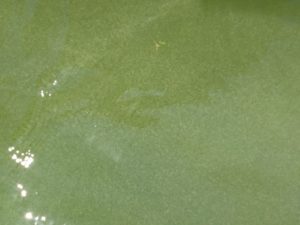 August 7, 2020
August 7, 2020
To all of our neighbors and friends,
I am sorry it has taken so long to get back to you with more information. It is disappointing that we have yet to receive the results of the testing that was promised to us by last Friday. I still don’t have the testing results but I want you to know our present status on a number of issues prior to the weekend.
The picture of the cyanobacteria in Great Herring Pond was taken on Monday.
- Kim Tower (Plymouth Department of Marine and Environmental Affairs) and my wife Geri and I went out on Great Herring Pond to assess the status of the bloom and take additional samples including a new sample for the lab. According to Kim, if you can see cyanobacteria (fine, granular, yellow-green suspension below the surface), you should not be swimming, eating the fish, or allowing your dogs to drink from or swim in the pond. The bloom is extensive and is present throughout nearly all of Great Herring Pond. Geri took many water temperature readings in Great Herring Pond and they were 83o F to 84o Kim left the Plymouth microscope and flurometer with us along with sampling devices and other equipment and Geri taught herself how to use the microscope and take pictures. She sent some pictures to Hilary Snook, our EPA cyanobacteria expert, and he confirmed that the pictures are of the microcystis cyanobacteria that produce a poisonous toxin. Geri took another sample yesterday from the end of our dock; toxic microcystis was still present.
- It is unfortunate that we have not received lab results in a timely fashion. It has been nearly two weeks. So, when we finally see the bloom clear and get two clean tests a week apart, it will still be at least three more weeks before we can safely return to the water.
- I have attached a link to the Plymouth Board of Health Algae Bloom Information site. If you click on the top in red it will bring you to e-subscribe. Check the second box under Urgent Alerts. This will alert you for any Public Health Urgent Alerts including cyanobacteria blooms and any updates made to the advisories.
https://www.plymouth-ma.gov/public-health-department/pages/algae-blooms-faqs
- Little Herring Pond and Carters River are still clear, thanks perhaps to their lower water temperatures and rapid flushing by springs. I learned from Jim Smith, one of our Water Quality Committee members and an expert on Little Herring Pond, that there are dozens of springs and seeps in Little Herring Pond. Hopefully, they will eventually flush Great Herring Pond clean.
- Our expert, Hilary Snook, will be giving a live Zoom presentation sponsored jointly by the Herring Ponds Watershed Association and Wildlands Trust on August 20 at 7:00 PM. Details for signing up and joining the Zoom presentation will follow in a future posting.
- Kim told us that just because we have a bloom one year, it does not mean that they will occur every year. This made me feel better but the Herring Ponds Watershed Association will not relax its efforts to find the cause of these blooms and eliminate it. You can help us “preserve and protect” this beautiful watershed by donating to the water quality fund. Your dollars are always welcome for projects such as stenciling storm drains with a “DO NOT USE FOR WASTE” and for investigative testing.
Be well, be safe.
Don Williams, President
Herring Ponds Watershed Association
July 30, 2020
 We Have Met Our Goal of Raising $10,000 for a Water Quality Plan!
We Have Met Our Goal of Raising $10,000 for a Water Quality Plan!
Thanks to your generosity, the Herring Ponds Watershed is able to commit to pay its share of the cost of the Water Quality Plan.
Hopefully the “After” picture (2020) with the green water will morph back to the “Before” picture with the blue, cyanobacteria-free water.
We have some good news in our battle against cyanobacteria blooms. The Herring Ponds Watershed Association share of $10,000 for the $80,000 Water Quality Plan has been raised. This plan will identify the origins of the phosphorus pollutant that enables the fast growth of the bloom, and suggest measures that will substantially reduce this pollution. We are optimistic that Town Meeting will approve Plymouth’s $70,000 expenditure for this plan with our good faith contribution. We will do our best to make sure that fall Town Meeting representatives know that this expenditure will help all ponds in Plymouth to better prevent harmful blooms. We are optimistic that we will find a way to control these blooms in the future using the results of this plan. We are optimistic that enough of you out there care about clean water to take on any other watershed problem that may arise. We are grateful for your contributions, your patience and your love for this special place.
What can we do now to hasten the demise of the cyanobacteria in Great Herring Pond?
- Pump out your septic tank. If you can’t remember the last time it was done, it’s probably time to do it.
- Don’t throw yard waste into the pond. Compost it instead. Yard waste requires oxygen to decompose. Lower oxygen levels in the pond encourage release of phosphorus pollutant from the pond sediment.
- Pick up after your pets so their waste doesn’t wash into the pond during a rain storm.
- If you have a yard service, ask them not to use phosphorus-containing fertilizer. There is plenty of phosphorus in the soil so it is not necessary to add any more. Professional landscapers are the only ones permitted to use phosphorus-containing fertilizer.
- If you do your own lawn work, don’t fertilize near the pond even if your fertilizer is phosphorus-free.
- Finally, and perhaps most important, don’t clear-cut your pond front land just to get a better view, especially if you’re property is sloped. Trees and shrubs hold the soil during torrential rainstorms and prevent runoff that physically transports soil and its phosphorus into the pond.
How else can you help?
Although we have reached our Water Quality Plan fundraising goal, we encourage you to contribute if you can ( you can donate on our website). Your donation will be designated for water quality improvement expenses and will be much appreciated when the plan tells us what must be done.
We have more good news:
- Hilary Snook, head of the regional EPA and cyanobacteria expert, has agreed to give a ZOOM presentation in August or early September to share his knowledge and answer your questions. Stay tuned for a date and time.
- We have tested the homeowner association beaches around Great Herring Pond for E.coli and the results of 11 tests show very low E. coli bacteria levels. Unlike cyanobacteria, these E. coli do not produce a powerful toxin but they will cause significant gastrointestinal stress if present. Why did we do this when no one should be swimming? The test also can detect septic system problem if an unanticipated spike in E. coli is observed in a usually clean area.
Don Williams, President
Herring Ponds Watershed Association
July 28, 2020
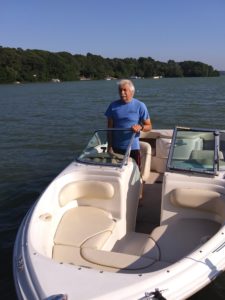 To my patient neighbors, the latest update.
To my patient neighbors, the latest update.
The condition of the pond seems to be improving!
Today, there were no “sworls,” “slicks” or “mats” of cyanobacteria cells.
Thank you for your patience waiting for the long-anticipated testing results. The sample, taken by Envirotech at the Boat Ramp and tested by them showed no cyanobacteria cells! Before you start jumping in the pond and drinking the water to celebrate, the advice of Plymouth’s Department of Marine and Environmental Affairs is to continue our current cautious behavior.
There are very good reasons for this approach:
- The tested sample was taken at the Boat Ramp and the sampler clearly stated that “there was no bloom visible when the sample was taken.” So, they happened to take a sample at one of the few places where there was no bloom!
- Blooms are still visible (as of today when Geri and I checked) although not in “sworls” or “slicks” or “mats” that had previously been seen. The blooms are less common near the shore and more prevalent farther out.
- We need two weeks in a row of zero cyanobacteria before we can re-open Great Herring Pond.
- We have had 3 dogs and 1 person (that I know of) with clear cyanobacteria reactions.
What are the next steps?
- Today, Kim Tower of the Plymouth Department of Marine and Environmental Affairs, has had another sample taken at the Boat Ramp to look for cyanobacteria.
- I suggested that an additional sample be taken that had the commonly observed, omnipresent (except at the Boat Ramp!) light green/yellow suspended particulate matter. Kim actually took 2 samples (one at Pond Road and the other at Great Herring Pond outlet) that clearly had this particulate matter. We will find out what the particulate matter is.
- Kim hopes to have analysis results by Friday.
Where does this leave us?
- Identification of the particulate matter is critical to ensure that reopening the pond is safe.
- A second zero cyanobacteria reading may lead to reopening of the pond if the particulate matter is definitely not cyanobacteria.
- If dogs and people get sick from drinking the water and swimming in the pond respectively, we need to find out why.
Kim just sent me another email.
- As long as there is a visual like today’s picture that I sent her, the advisory should remain based on the visual.
- She would be really surprised if the Pond Road sample came back “non-detect” since she “could see the cyanobacteria cells.”
- She will take a sample next week and I will take her out to look for the most concentrated bloom area.
We do not want a repeat of the past 10 days. We will, with your help, work to learn more about this incident and what we need to do to prevent it from happening again. Without doubt, the cloudiness and green color in the water caused by the particulate matter is the result of some form of pollution. Knowing what the pollutant is will help us to deal with it. Unfortunately, cyanobacteria is still likely to be present.
In the meantime, keep safe. The noticeable improvement in water color and the lack of large “sworls,” “slicks” or “mats” give us hope that the bloom is clearing. Please, however, let’s not make the mistake of “opening up too soon.”
Don Williams, President
Herring Ponds Watershed Association
July 26, 2020
To all of you who have read our posts, asked questions and sent contributions:
Thanks so much for your support!
To summarize the Great Herring Pond situation:
- There are still a lot of cyanobacteria in Great Herring Pond.
- Those not aware of the cyanobacteria bloom invariably have come in from the boat ramp.
- One more dog has taken ill from drinking the water.
- We still do not have testing results.
- Your donations toward the Water Quality Plan are making a huge difference.
- Response to the new, larger signs was very positive.
Hilary Snook, Head of the regional EPA and cyanobacteria expert, is working tonight and has answered some of your questions that I forwarded on to him:
Question: Will we have to replace the noodles, ropes and buoys that mark the swimming areas?
Answer: No, you won’t need to replace any swimming area equipment.
Question: Will we contaminate other ponds if we take our boat there?
Answer: The likelihood of “seeding” another lake is small as it doesn’t work the same as say invasive Eurasian milfoil. If one was worried, I would say just keep the boat out of the water for a day or two before going to another lake.
Question: Are there ways to speed up the disappearance of the bloom?
Answer: There are a lot of technologies out there and some work better than others depending on the algae/cyanobacteria, lake morphology and size, hydrology, etc. I am not an expert in all of the various types of treatment, but I have been on a working group compiling all of the known technologies and treatments and summarizing their efficacy, cost, etc. The site is not quite ready for prime time, but it is getting close. I wouldn’t jump at a quick remedy at this point. It usually takes some work to understand the system and know what will be the best strategy.
Be well, be safe and keep your thoughts, ideas and questions coming in!
Don Williams, President
Herring Ponds Watershed Association
July 24, 2020
To all of our loyal followers,
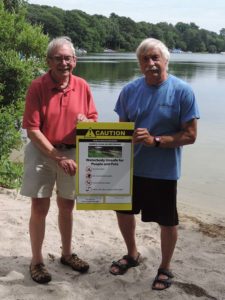 Jerry Levine (Board of Directors, Invasives Committee Chair, Plymouth Board of Health) and I posted 2 new, large (14″ x 22″) signs at the boat ramp (permission granted by Bourne) and 6 at home owner association beaches around Great Herring Pond. It is our hope that these signs will be more visible than the the previous signs and prevent illness and discomfort. Thanks to Jerry for getting the signs made and for making sure they were delivered before what promises to be another hot weekend.
Jerry Levine (Board of Directors, Invasives Committee Chair, Plymouth Board of Health) and I posted 2 new, large (14″ x 22″) signs at the boat ramp (permission granted by Bourne) and 6 at home owner association beaches around Great Herring Pond. It is our hope that these signs will be more visible than the the previous signs and prevent illness and discomfort. Thanks to Jerry for getting the signs made and for making sure they were delivered before what promises to be another hot weekend.
A summary reminder of “DON’Ts” is in order:
- Don’t drink the water.
- Don’t let your dog drink the water.
- Don’t swim in the water (especially children and dogs).
- Don’t eat the fish you catch; release them.
- Be careful to wash thoroughly if you have to walk in the water (especially children and dogs).
We are humbled by your response to our call for help to raise the Herring Pond Watershed’s share of $10,000 toward the $80,000 Water Quality Plan. The WQP is the best way to determine the source of nutrients (phosphorus), the only cyanobacteria growth variable that is readily controllable. The WQP will also suggest ways to limit phosphorus in our watershed ponds and prevent recurrences of these blooms in the future. So far, we have raised $1410 on Facebook and have had additional WQP donations and pledges of $1100. Our Board of Directors has pledged $1600, bringing the total thus far to $4110. Adding in the match promise of $1 for every $2 raised brings the total up to $6165. We are getting close and optimism is rising. Your generosity has played a critical role in this process. Thank you. (Click here to go to the Donations page)
We have not yet received the testing results. I will let you know when I find out.
You have asked if it is safe to sit out near the pond. I have again approached my expert contact, Hilary Snook, head of the regional EPA and cyanobacteria authority. He said that he personally wouldn’t be too worried. If it was happening all the time and you were exposed to long-term chronic exposure then he might be concerned. He would just err on the side of caution; if it smells noxious, keep your distance and if it is choppy and a bloom is breaking up along the shoreline, just stay away until it dissipates.
The bloom is still very much with us but Little Herring Pond and Carters River still appear clear. We are monitoring both visually.
Please take the time to warn those doing any of the “DON’Ts” above. If they appear skeptical, advise them that one of our residents was in the hospital with welts and shingles-like rashes from swimming in the water and two dogs are still seriously ill. I will be vigilant this weekend also.
Thanks for your support.
Don Williams, President
Herring Ponds Watershed Association
July 22, 2020
We will be getting larger (14″ x 22″) two-sided signs with metal holders on Friday. Jerry Levine and I will post them at the boat ramp and at the home owner’s association beaches. The current signs are small and are not easily seen. They are due to come in on Friday and will be up before the weekend. The Town of Bourne has no problem with us putting a sign up at their boat ramp.
We have not received results from the testing lab on the concentration of the cyanobacteria. We should hear soon or early next week, depending on who you believe. This will provide a good baseline number for comparison of next week’s result and subsequent results. As of this morning, there was still a lot of cyanobacteria present.
Some of went out this morning to collect samples for E. coli testing at the major swimming beaches on Great Herring Pond. We learned more about the resident who was hospitalized from swimming last week in the pond. Her allergic reaction was quite severe and required lengthy hospitalization. She is now resting at home.
The toxins produced by cyanobacteria produce allergic reactions in some people upon contact. Not all react in the same way and to the same degree, typical of allergic responses. However, ingestion of this cyanobacteria-containing water would make most adults and all children and dogs very ill.
Fish eat the cyanobacteria and are NOT safe to eat. The birds that eat fish (herons, terns) are at risk. In my travels, though, I have not seen any dead fish.
We have results on the temperatures of Great and Little Herring (thanks Lee Pulis and Jim Smith) Ponds. Great Herring Pond varied from 78 – 84 F, with 80.3 F being the average of 13 readings. Little Herring Pond was 52.7 F at the spring and went up to 77.7 F and averaged 70.7 F (8 readings). At the very least, we can conclude that Great Herring Pond, being 10 F warmer than Little Herring Pond, provides a better environment for cyanobacteria. Little Herring Pond, as of Monday at least, had no visible cyanobacteria.
At present, we have raised $925! Thanks to all of you for your kindness and generosity. The funds are much needed to help pay the Herring Ponds Watershed Association portion of the Water Quality Plan that will tell us how to deal with reducing the nutrient input into the pond and hopefully preventing future blooms. (Donate here)
Keep your comments and suggestions coming!
Don Williams, President
Herring Ponds Watershed Association
July 21, 2020
Thanks to everyone for being so understanding during the current cyanobacteria bloom. I went out yesterday in my boat around 1:30 PM and, despite the hot weather, no one was in the water, very few boats were out and even Three Rocks was empty.
I have gotten a report that a dog that was swimming (and drinking the water) took ill but is recovering. The evidence (even minus the needed testing) is pretty clear that this cyanobacteria bloom is toxic.
I talked to David Gould, head of Plymouth’s Department of Marine and Environmental affairs, to clarify the status of the testing. He confirmed that the identification of the cyanobacteria by the state was made based on photographs and that no other test had been done. David had a sample taken yesterday and results should be available “in a couple of days.” He said that since there are no public beaches on Great Herring Pond, Plymouth would not be able to pay for extensive testing. He did, however, agree to have two initial samples taken at Plymouth expense. The sample testing is expensive ($150 per test) and David is working in an emergency “1/12” budget situation because Town Meeting hasn’t met yet to pass a budget because of coronavirus concerns. Town Meeting is scheduled for August 10. In order to re-open Great Herring Pond (GHP), two successive weeks of testing with no cyanobacteria present will be necessary. As you know from Hilary Snook’s input (Hilary is the regional EPA head and cyano expert), there is no way of knowing how long the bloom will last. The good news is that GHP is flushed by river ingress (Carters River) and egress (Herring River). The bad news is that the bloom is extensive and we still have most of the summer heat to contend with. I have agreed to monitor the status of the bloom and, once it seems to have dissipated, take the necessary samples for testing so that the pond can re-open. We cannot afford to pay for weekly testing and it makes no sense to test if cyanobacteria is still visible and extensive.
I have consulted with Hilary Snook and Hampton Watkins (Long Pond Association Water Quality Chair) about what might have caused this bloom. It is the first on GHP for at least 80 years according to old timers who have never seen such a bloom. It is clear that once blooms start on a pond, they are likely to continue (Snook). It is therefore very important that we understand what drives these blooms and develop strategies to prevent their return. The current bloom is certainly the result of a “perfect storm.” The components of the cyanobacteria “perfect storm” are: 1) heat, 2) light, 3) nutrients and 4) “hydrologic conditions.”
We have had heat — weather has been hot lately and, due to a warm winter, the water temperature started off warmer this spring and has risen to 78 – 84 F (taken yesterday afternoon). It also explains why Little Herring Pond (LHP) is still clean; temperatures in LHP range from 52.7 at the spring to 77.7 F (taken by Jim Smith and Lee Pulis yesterday late morning).
We have had light — there has not been much rain in the area so there have not been many cloudy days. Although we are not under severe drought conditions, rain has been relatively scarce.
We have had a couple of intense rainstorms the week of July 5 that could have easily provided the phosphorus nutrients via runoff.
Hilary got back to me about the “hydrologic conditions” that would be conducive to cyanobacteria blooms. They include less snow melt (check), low rainfall (check) and additional storm water infrastructure (check – our 3 runoff remediations — ironic, yes?).
So, where does this leave us? We can hope that there will be no more “perfect storm” situations (possible but not a 100% chance at all). We can hope that Mother Nature cooperates (not a good bet because all climate change effects are in the wrong direction). Or we can work on minimizing nutrient entrance into our ponds. Of course, individually we can pump septic tanks religiously every 3 – 5 years, avoid phosphorus-containing fertilizers and refrain from throwing leaves and such into the pond, but the biggest contribution will undoubtedly be to reduce runoff. The Herring Ponds Watershed Assoication is working with David Gould to fund an $80,000 study that will result in a Water Quality Plan that will both identify the likely sources (in order of importance) of nutrients and suggest ways to remediate this pollution. This will be considered at fall Town Meeting. We must raise $10,000 as the Herring Ponds Watershed Association contribution toward this study so be generous when asked to help out. Moreover, if you live on or near GHP, please refrain from clear cutting your property down to the pond so that you can have a better view. It leads to runoff and encourages others to do the same.
Hampton Watkins told me that there is always some cyanobacteria in the ponds in our area, waiting to bloom. We just have to do our best to not give it everything it needs. Control of nutrients is our best tactic.
We should have test results in “a couple of days” according to David Gould. The results will confirm the presence of the cyanobacteria (probably a foregone conclusion) and the concentration. Anything above 70,000 cells/milliliter is severe enough to shut down the pond. We will let you know when we receive that information.
Also, I found out from Hampton Watkins that it is not safe to eat fish taken from GHP. He asked if we’d seen evidence of fish kill yet. We have not and that is a good sign but not one that we should take as an excuse to let down our guard. Dogs and humans have already suffered from exposure. Hampton also said that birds eating the contaminated fish are also at risk.
I regret the length of this note but my experience as a scientist has taught me that the more people who know about the problem and the more that they know are keys to solving the problem. Be well and thanks for your support, cooperation and kind words.
Don Williams, President
Herring Ponds Watershed Association
